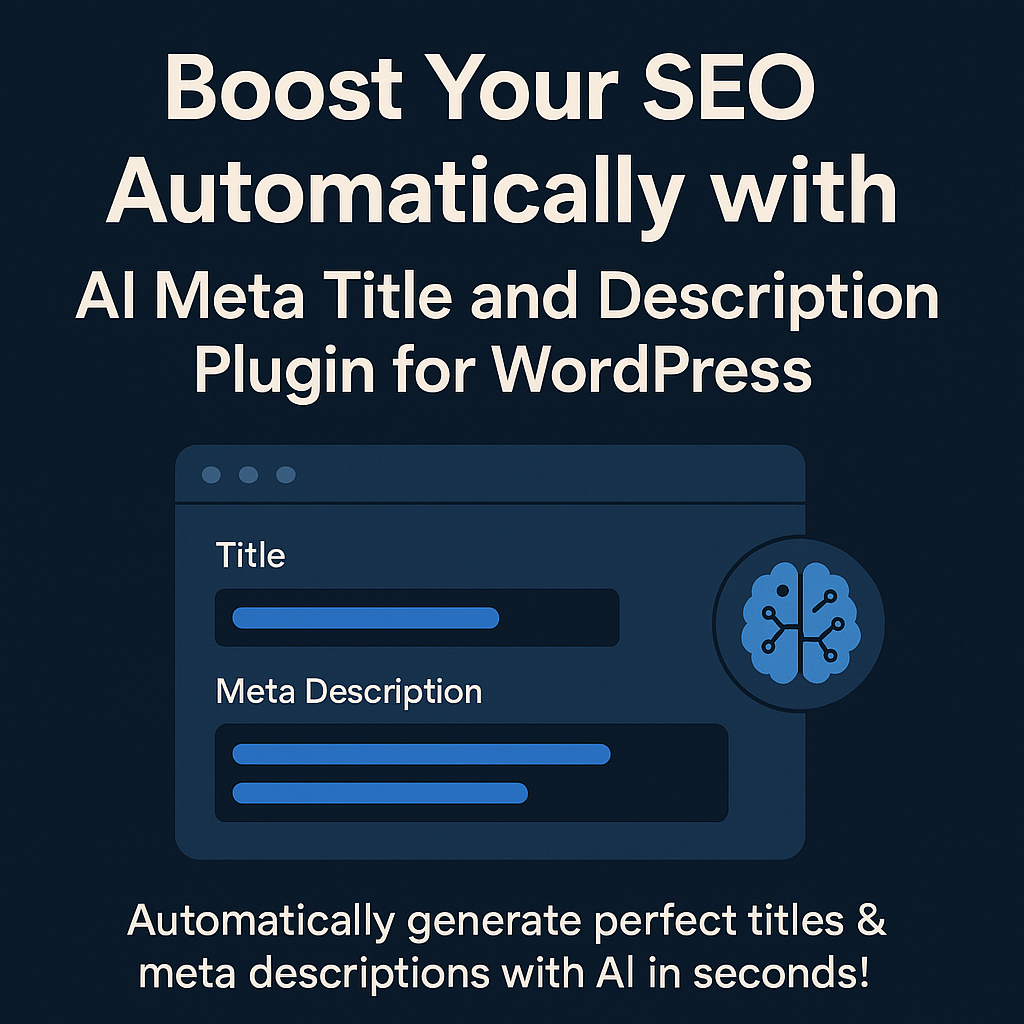
AI Meta Title and Description Plugin for WordPress – The Ultimate Guide to Automating Your SEO

Introduction: The Unseen Power of a Perfect Snippet
In the vast, sprawling digital cosmos of the internet, where over 4.5 billion web pages compete for attention, your website is a single star among billions. How does it shine brighter? How does it attract the celestial traffic of visitors, readers, and customers? The answer, more often than not, begins not with a flashy homepage or a viral social media post, but with a humble, often overlooked element: the meta title and description.
These two lines of text—the blue, clickable headline and the short paragraph of text beneath it on a Search Engine Results Page (SERP)—are your digital storefront. They are your first impression, your elevator pitch, and your handshake with the world. They are the decisive factor that determines whether a potential visitor clicks on your link or scrolls past to a competitor.
For years, crafting the perfect meta title and description has been a tedious, manual, and often inconsistent process. Bloggers, content creators, and SEO managers have spent countless hours staring at character counters, agonizing over keyword placement, and testing different calls to action. This process is not only time-consuming but also prone to human error and creative fatigue.
But what if you could harness the power of artificial intelligence to automate this process? What if you could generate dozens of perfectly optimized, engaging, and relevant meta tags with a single click?
This is no longer a futuristic fantasy. It is the present, and it is revolutionizing how we approach SEO.
Welcome to the definitive guide to the AI Meta Title and Description WordPress Plugin—your intelligent SEO co-pilot, designed to save you time, enhance your consistency, and skyrocket your click-through rates. This article will serve as a deep dive into the world of meta tags, the transformative power of AI, and how this specific plugin can become the most valuable addition to your WordPress toolkit.
Chapter 1: The Foundational Pillars of SEO – A Deep Dive into Meta Titles and Descriptions
Before we explore the solution, we must first fully understand the problem and the opportunity. Meta tags are not just arbitrary fields in your WordPress editor; they are fundamental components of on-page SEO and user experience.
1.1 What Exactly Are Meta Titles and Descriptions?
- Meta Title (Title Tag): This is the HTML element
<title>that specifies the title of a web page. It is displayed as the clickable headline in SERPs and is also shown in the browser’s title bar and tab. It is the single most important on-page SEO element. - Meta Description: This is the HTML attribute
<meta name="description" content="...">that provides a concise summary of the web page’s content. While not a direct ranking factor, its primary purpose is to advertise the page’s content and entice users to click.
1.2 The Multifaceted Role of Meta Tags in the SEO Ecosystem
Their importance is multi-layered, impacting both machines (search engines) and humans (users).
For Search Engines:
- Context and Relevance: Meta titles are a strong, direct signal to search engine crawlers about the page’s primary topic. A well-crafted title with a primary keyword helps Google’s algorithm understand and categorize your content accurately.
- Keyword Signaling: While meta descriptions don’t directly influence rankings, the keywords within them are bolded in SERPs when they match a user’s query. This indirect effect can significantly boost visibility and perceived relevance.
- Indexing and Crawl Efficiency: Clear, unique meta tags help search engine bots parse and index your site’s structure more effectively, ensuring that all your important pages are discovered and cataloged correctly.
For Human Users:
- The Decisive First Impression: In the high-speed, split-second environment of a search results page, users are scanners. They don’t read; they skim. Your meta tag duo is your one and only chance to capture their attention and convince them that your page holds the answer they seek.
- Managing Expectations: A accurate meta description sets clear expectations for the content. When the page delivers on the promise made in the snippet, user satisfaction increases, leading to longer dwell times and lower bounce rates—which are positive, indirect ranking signals.
- The Call to Action (CTA): A meta description is a form of ad copy. Phrases like “Learn More,” “Discover the Secrets,” “Get Your Free Guide,” or “Compare the Top 10” act as psychological triggers that compel users to click.
1.3 The Dire Consequences of Neglect: What Happens When You Ignore Meta Tags?
The default behavior of WordPress and many themes is to auto-generate meta tags, often by using the post title as the meta title and the first few lines of content as the meta description. This is a catastrophic SEO misstep.
- Inconsistent Branding: Your brand name might be missing from titles, or the description might be a jumbled, incomplete sentence.
- Poor Keyword Optimization: Auto-generated tags rarely include the primary and secondary keywords you’re targeting.
- Duplication: Multiple pages can end up with identical or very similar meta tags, causing confusion for search engines and leading to cannibalization where your pages compete against each other.
- Missed Opportunities: You fail to leverage the snippet as a powerful marketing tool, resulting in abysmally low click-through rates even for pages that rank well.
The manual creation of meta tags is the solution to this neglect, but it brings its own set of challenges: it’s monotonous, time-intensive, and difficult to scale, especially for large websites, e-commerce stores, or busy agencies. This is the critical gap that AI seamlessly fills.
Chapter 2: The AI Revolution in Content Optimization
Artificial Intelligence, particularly in the form of Large Language Models (LLMs) like OpenAI’s GPT, has transcended the realm of science fiction to become a practical, powerful tool for digital marketers and content creators. Its application in SEO is not about replacing human creativity but about augmenting it, handling repetitive tasks with superhuman speed and consistency.
2.1 How Does AI Generate Human-Quality Text?
AI models like GPT are trained on a significant portion of the internet’s text data. They learn the patterns, structures, nuances, and contexts of human language. When you provide a prompt—such as the body of your blog post—the AI analyzes it, understands its core themes and intent, and then generates new text that is coherent, contextually relevant, and stylistically appropriate. It’s like having a professional copywriter who has read millions of articles and can instantly produce a perfect summary for yours.
2.2 The Symbiotic Relationship: AI and the SEO Professional
The fear that AI will replace SEO experts is unfounded. Instead, it creates a powerful synergy:
- The SEO Strategist (Human): Defines the strategy. They conduct keyword research, understand user intent, analyze competitor gaps, and set the overall content direction. They are the architects.
- The AI Assistant (Machine): Executes the tactics. It generates multiple meta tag variations, ensures keyword inclusion, adheres to character limits, and maintains a consistent brand voice across thousands of pages. It is the construction crew.
This partnership frees up the SEO professional to focus on high-level strategy, data analysis, and creative campaigns, while the AI handles the labor-intensive groundwork.
Chapter 3: Introducing Your SEO Game-Changer – The AI Meta Title and Description Plugin
The AI Meta Title and Description plugin is a sophisticated WordPress plugin built specifically to bridge the gap between the power of AI and the daily practicalities of website management. It is designed to be both incredibly powerful and remarkably simple to use.
3.1 Core Philosophy and Value Proposition
The plugin operates on a simple but profound value proposition: to eliminate the friction and time cost associated with creating high-quality meta tags, thereby ensuring that every page on your website, from the newest blog post to the oldest product listing, is optimized for maximum search visibility and click-through rate.
It transforms a task that was once a chore into a one-click, instantaneous action.
3.2 Seamless Integration: How the Plugin Works
The beauty of the plugin lies in its simplicity. The process is designed to be intuitive for users of all technical levels.
- Installation and Activation: The plugin is installed like any other from the WordPress repository. Once activated, it adds a new meta box within the WordPress post/page editor.
- API Connection: You navigate to the plugin’s settings and enter your unique OpenAI API key. This secure key is the bridge that allows the plugin to communicate with the AI model. The plugin does not store or handle your data; it merely acts as a conduit.
- Content Analysis: You write your post or page content as you normally would within the Classic Editor or the Gutenberg block editor.
- One-Click Generation: When you are ready, you simply click the “Generate with AI” button within the plugin’s meta box.
- AI Processing: The plugin sends the content of your post to the OpenAI API. The AI model analyzes the entire text, identifies the main topics, key entities, and overall sentiment.
- Instant Results: Within seconds, the plugin receives the AI-generated meta title and meta description and populates the respective fields in your WordPress editor.
- Human-in-the-Loop Review and Edit: This is the crucial final step. You review the generated text. You can use it as-is, tweak it for a specific tone, add a power word, or simply hit “Generate” again for a different variation. You retain full creative and strategic control.
Chapter 4: An Exhaustive Look at Powerful Features
The plugin’s core functionality is just the beginning. It is packed with features designed for flexibility, power, and scalability.
- One-Click AI-Powered Generation: The flagship feature. No copying, no pasting, no switching tabs. The magic happens right inside your native WordPress workflow.
- Deep Integration with OpenAI API: Leverages the industry’s most advanced and reliable language model, ensuring the highest quality and most coherent output.
- Lightweight and Performance-Focused: Coded with best practices, the plugin adds no unnecessary bloat to your website, preserving your precious loading speeds—a critical ranking factor in itself.
- Universal Editor Compatibility: It works flawlessly with both the traditional Classic Editor and the modern Gutenberg (Block) Editor, ensuring no user is left behind.
- Custom Post Type Support: Your meta tags aren’t just for posts and pages. The plugin can generate tags for Products (WooCommerce), Portfolio items, Events, and any other custom post types your site uses.
- Multilingual and International SEO Support: For global websites, the plugin can generate meta tags in various languages, compatible with popular translation plugins like WPML and Polylang, making it a powerhouse for international SEO campaigns.
- Keyword-Focused Prompting (Premium): The premium version allows you to specify a primary keyword. The AI will then be instructed to prioritize this keyword in the generated title and description, aligning perfectly with your target SEO strategy.
- Tone of Voice Customization (Premium): Is your brand voice professional and authoritative? Friendly and conversational? Witty and sarcastic? The premium plugin allows you to set a tone, and the AI will adapt its writing style to match your brand’s unique personality.
- Batch Generation for Unmatched Scalability (Premium): This is a game-changer for large sites. With batch processing, you can select hundreds of old blog posts or product pages that lack meta descriptions and generate optimized tags for all of them in a single, automated operation. This can save hundreds of hours of manual work.
Chapter 5: Real-World Applications and Use Cases
The versatility of the AI Meta Title and Description plugin makes it an indispensable tool across a wide spectrum of users and industries.
- The Prolific Blogger and Content Marketer: For anyone running a content-heavy website, the plugin eliminates the “meta tag bottleneck.” After spending hours writing a 2,000-word masterpiece, the last thing you want to do is spend another 15 minutes crafting the perfect snippet. With AI, it’s done in seconds, ensuring every new post is published fully optimized.
- The E-commerce Store Owner: A WooCommerce store with 500 products has 500 pages that need unique, compelling meta tags. Manually writing these is a Herculean task. The AI plugin can automatically generate product-specific titles and descriptions that highlight key features, benefits, and USPs, dramatically improving product visibility in search.
- The Digital Marketing Agency: Agencies managing dozens of client websites need efficiency and consistency. This plugin allows them to deploy a standardized, high-quality meta tag creation process across all clients, improving deliverable quality and freeing up account managers to focus on strategy and client communication.
- The Niche Site and Affiliate Marketer: For sites built around reviewing products or targeting long-tail keywords, precise meta tags are crucial. The AI can quickly generate multiple variations for A/B testing to see which titles and descriptions yield the highest CTR for specific keyword groups.
- News Portals and Magazine Websites: With a high volume of daily publications, speed is essential. Journalists and editors can use the plugin to instantly generate news-optimized meta tags that are timely, accurate, and click-worthy, ensuring their breaking news articles gain maximum search traction immediately.
- The Local Business Owner: A local bakery, plumber, or law firm can use the plugin to ensure their service pages, “About Us” page, and contact page have locally-focused meta tags that include their city and core services, improving their visibility in “near me” searches.
Chapter 6: The Tangible SEO Benefits – A Data-Driven Approach
Implementing this plugin is not just a convenience; it’s a strategic SEO move with measurable outcomes.
- A Dramatic Increase in Click-Through Rate (CTR): This is the most immediate and direct benefit. By consistently producing compelling, benefit-driven meta descriptions, you make your listing stand out in the SERPs. A higher CTR sends a positive quality signal to Google, which can indirectly lead to improved rankings over time.
- Comprehensive On-Page SEO Consistency: The plugin ensures that not a single page on your site is left behind. From your cornerstone content to your obscure category archives, every page will have a unique, descriptive, and keyword-appropriate meta tag set. This creates a strong, unified SEO footprint.
- Significant Time Savings and Enhanced Productivity: If it takes an average of 5 minutes to manually craft a good meta title and description, and you publish 10 articles a month, that’s nearly an hour saved. For an e-commerce site with 1,000 products, that’s over 83 hours of work automated. This time can be reinvested into higher-value activities like link building, content strategy, or data analysis.
- Reduced Bounce Rates and Improved User Engagement: By accurately summarizing page content, the AI-generated tags attract genuinely interested visitors. These users are more likely to read the article, watch the video, or explore the product, leading to lower bounce rates and higher engagement metrics—all of which are favorable SEO signals.
- Scalable Optimization for Historical Content: Many websites have a vast archive of old but valuable content that lacks proper meta tags. The batch generation feature allows you to audit and optimize this entire back catalog in one fell swoop, potentially unlocking new traffic from old posts.
- Data-Driven A/B Testing: The ability to generate multiple variations instantly allows you to experiment. You can test different value propositions, CTAs, and emotional triggers in your meta descriptions to see what resonates most with your audience.
Chapter 7: Addressing Security, Privacy, and Best Practices
7.1 Is It Secure and Private?
This is a paramount concern. The AI Meta Title and Description plugin is designed with security first.
- Your API Key, Your Control: You provide your own OpenAI API key. The plugin itself does not store or have access to your key. All communication between your website and the OpenAI API is encrypted via HTTPS.
- No Data Storage: The plugin does not store, sell, or share your website’s content. The post content sent to OpenAI for processing is not used by OpenAI to train its models (as per their API data usage policies). It is processed and then discarded after the generation is complete.
- Self-Contained Operation: The plugin runs entirely within your WordPress environment and communicates directly with the official, secure OpenAI API endpoint.
7.2 Best Practices for Optimal Results
To get the most out of the plugin, follow these expert tips:
- Write Comprehensive Content First: The AI can only work with what you give it. Ensure your blog post or product description is detailed, well-structured, and covers the topic thoroughly. The better the input, the better the output.
- Always Review and Refine: Never blindly publish AI-generated content. Use it as a first draft. Add your brand’s unique flair, ensure the primary keyword is present, and check that the call to action is strong.
- Mind the Character Limits: The plugin is designed to respect limits, but always double-check. Meta Titles should ideally be under 60 characters, and Meta Descriptions under 160 characters to avoid truncation in SERPs.
- Use the Keyword Field (Premium): If you have the premium version, always specify your target keyword. This focuses the AI’s efforts and ensures your primary SEO target is front and center.
- Leverage Batch Generation for Site Audits: Use the batch feature during your quarterly or bi-annual SEO audits to refresh and re-optimize meta tags across your entire site, keeping your SEO fresh and competitive.
Chapter 8: Pricing, Value, and Getting Started
8.1 Transparent and Accessible Pricing Structure
The plugin is committed to providing value to users of all sizes.
- Free Version: Perfect for bloggers, small businesses, and low-volume websites. It includes the core one-click generation feature for posts and pages, allowing you to experience the power of AI-driven SEO at no cost.
- Premium Version: Designed for professionals, agencies, and high-traffic websites. It unlocks the full potential of the plugin, including:
- Batch Generation
- Keyword Insertion
- Custom Tone of Voice
- Support for Custom Post Types
- Priority Email Support
- Regular Feature Updates
The premium version is priced as a yearly subscription, offering incredible ROI by the time and traffic it saves.
8.2 Your Onboarding Checklist: How to Get Started in 5 Minutes
- Download: Install the “AI Meta Title and Description” plugin from the WordPress.org plugin directory directly from your dashboard.
- Acquire API Key: Sign up for an account at OpenAI and generate an API key from your dashboard. Note that using the API comes with a minimal cost per request, but generating a meta tag typically costs a fraction of a cent.
- Configure: Enter your API key in the plugin’s settings page within your WordPress admin area.
- Generate: Create a new post or page, write your content, and click the “Generate with AI” button.
- Publish and Prosper: Review the output, make any final tweaks, and hit publish, confident that your SEO fundamentals are perfectly in place.
Chapter 9: The Future of AI and SEO
The integration of AI into SEO is still in its early stages, but its trajectory is clear. The future will involve even more sophisticated tools that can:
- Perform Real-Time SERP Analysis: AI could analyze the top 10 results for a keyword and generate a meta tag specifically designed to outperform them.
- Predict CTR Based on Snippet Composition: Using historical data, AI could predict which version of a meta description is likely to achieve the highest click-through rate before you even publish.
- Generate Fully Optimized Content Outlines: The plugin could evolve to suggest not just meta tags, but the entire structure and key points of an article based on a target keyword.
The AI Meta Title and Description plugin is your first and most crucial step into this exciting future.
Conclusion: Stop Toiling, Start Automating
SEO is a long game, a marathon composed of a thousand tiny sprints. Every optimized image, every internal link, every well-structured heading, and every perfect meta tag contributes to the final outcome. For too long, the creation of meta tags has been a tedious, manual sprint that drains resources and morale.
The AI Meta Title and Description WordPress Plugin changes the game. It automates this critical task with precision, consistency, and intelligence. It is more than just a plugin; it is a force multiplier for your SEO efforts, a strategic investment that pays dividends in saved time, improved traffic, and enhanced search visibility.
Don’t let the bottleneck of meta tag creation slow down your growth. Embrace the power of AI, empower your WordPress website, and watch as your search engine presence transforms from an afterthought into your most reliable channel for sustainable, organic growth.
Install the AI Meta Title and Description plugin today and experience the future of SEO.





